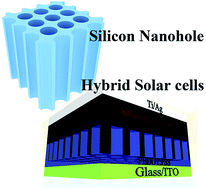Optical trapping enhancement from high density silicon nanohole and nanowire arrays for efficient hybrid organic–inorganic solar cells†
Abstract
In this paper, we employ a series of metal-assisted chemical etching processes to fabricate low-cost silicon nanohole (SiNH) and silicon nanowire (SiNW) arrays for hybrid solar cells. The SiNH arrays and SiNW arrays are obtained by a two-step etching and one-step etching technique, respectively. Length and depth of SiNWs and SiNHs can be controlled by etching time. The SiNH arrays demonstrate higher optical trapping effect than SiNW arrays, resulting in leading performance power conversion efficiency of 11.25% in the hybrid organic–inorganic solar cells. SiNH arrays have a high surface area, compared to SiNW arrays, so they can give rise to more junction area in the organic–inorganic heterojunction structures. In addition, these SiNH arrays possess additional advantages of robust structures and higher density with low air-filling fraction as compared to SiNW arrays. Furthermore, the SiNH arrays show superior efficiency to SiNW arrays experimentally. In particular, the fabricated SiNH arrays with high density can suppress the optical reflection well below 5% over a broad wavelength range from 300 to 1100 nm in a short nanohole depth. The very low reflectance and excellent light trapping property are attributed to the sub-wavelength dimension of the SiNH structure. These SiNH arrays not only facilitate the optical trapping, but also provide efficient broadband and omnidirectional photon harvests for cost-effective future nanostructured photovoltaics.


 Please wait while we load your content...
Please wait while we load your content...